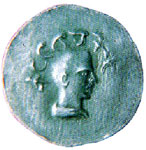| Kuttuvan Kotai | |
|---|---|
 Kuttuvan Kotai. Legend in Tamil-Brahmi: "Ku-t-tu-va-n Ko-tai" Kuttuvan Kotai. Legend in Tamil-Brahmi: "Ku-t-tu-va-n Ko-tai" | |
| House | Chera dynasty |
Kuttuvan Kotai (Tamil: குட்டுவன் கோதை), also spelled Kothai/Kodai, was a Chera ruler of early historic (pre-Pallava) south India.
Silver coins bearing a portrait facing right with Tamil-Brahmi legend "Ku-t-tu-va-n Ko-tai" have been discovered from Amaravati riverbed in Karur, central Tamil Nadu. The reverse of the coins are blank. The coin seems to be an imitation of the Roman portrait head coins. Whether these coins were used as a currency in trade transactions is not clear.
Scholars identify Kotai with "Cheraman Kuttuvan Kotai" mentioned in the early Tamil text Purananuru, 54. This Chera is mentioned as Kotai, not as Kuttuvan Kotai, in the body of the poem, but the appended colophon gives the full name "Kuttuvan Kotai". The Chera is eulogized in the Puram by Konattu Ericchalur Matalur/Matalan Madurai Kumarananar (Purananuru). The son of Chera ruler Cenkuttuvan was also referred to as "Kuttuvan Cheral".
Kuttuvan was probably an ancient title for the Chera rulers of south India. Early Tamil texts refer to "Kuttuvar" as a kingship group and "Kuttanatu" as the country of the Kuttuva people. The term Kuttanatu is indicated in the entry in Periplus Maris Erythraei, referring to "Cottonora", ‘where the pepper grows’. The estuarine region Kottayam and Alappuzha districts of Kerala is now known as Kuttanatu.
References
- ^ Aiyar, K. G. Sesha (1937). Chera Kings of the Sangam Period. London: Luzac and Co. pp. 53–54.
- ^ Rajan, K. (2011), "Emergence of Early Historic Trade in Peninsular India", Early Interactions between South and Southeast Asia: Reflections on Cross-Cultural Exchange, ISEAS–Yusof Ishak Institute, pp. 182–183, ISBN 978-981-4311-17-5
- ^ Champakalakshmi, R. (1996). Trade, Ideology, and Urbanization: South India 300 BC to AD 1300. Oxford University Press. pp. 111 and 137.
- Mahadevan, Iravatham (2003). Early Tamil Epigraphy: From the Earliest Times to the Sixth Centuy AD. Harvard Oriental Series. Cre-A and Harvard University. pp. 117–119 and 62–63.
- ^ Majumdar, Susmita Basu (2017). "Money Matters: Indigenous and Foreign Coins in the Malabar Coast". In Mathew, K. S. (ed.). Imperial Rome, Indian Ocean Regions and Muziris: New Perspectives on Maritime Trade. Routledge. pp. 410–411.
- ^ Ganesh, K. N. (2009). "Historical Geography of Natu in South India with Special Reference to Kerala". Indian Historical Review. 36 (1): 3–21. doi:10.1177/037698360903600102.